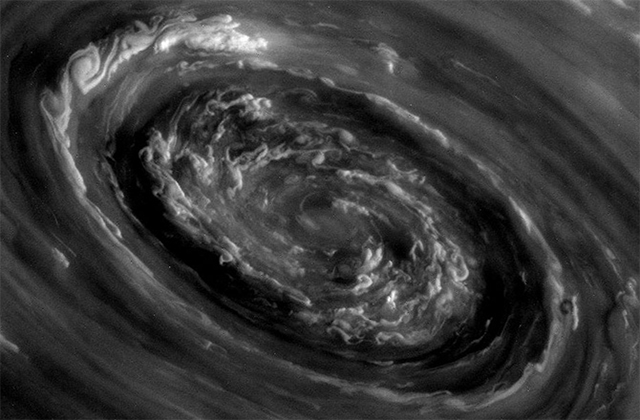
NASA/JPL-Caltech/Space Science Institute
Many thunderstorms in Saturn’s atmosphere could be driving the gas giant’s vast polar cyclones, according to new simulations inspired by observations from NASA’s Cassini spacecraft. What’s more, this research could help astronomers study large-scale atmospheric phenomena on exoplanets light-years away.
For decades, the powerful, swirling hurricane-like features at Saturn’s poles have been a mystery – what drives these storms and why do they persist for so long? Associated with these vortexes are “hot-spots” as observed by Cassini.
In addition, Saturn’s north polar cyclone is surrounded by a mesmerizing hexagonal feature etched into the atmosphere. The hexagon is thought to be a product of turbulent eddies surrounding the central vortex, so scientists want to understand the driving forces behind these powerful atmospheric flows as an answer to the hexagon may also be found.
On Earth, cyclones are driven by the flow of moisture over oceans. However, Saturn certainly does not possess huge masses of water, making astronomers look for other clues as to how a cyclone could form.
Using a planetary model of Saturn, new research published in the journal Nature Geoscience suggests that it could be many small thunderstorms in Saturn’s tumultuous atmosphere that combine to form these vast swirling cyclones.
“Before it was observed, we never considered the possibility of a cyclone on a pole,” said lead author Morgan O’Neill, former PhD student in MIT’s Department of Earth, Atmospheric and Planetary Sciences (EAPS) and now a postdoc at the Weizmann Institute of Science in Israel. “Only recently did Cassini give us this huge wealth of observations that made it possible, and only recently have we had to think about why [polar cyclones] occur.”
O’Neill’s team was able to create a simple model of Saturn’s atmosphere that generated many small thunderstorms over time. Taking simple atmospheric dynamics into account, they found that the many storms pulled atmospheric gases toward the poles – a mechanism known as “beta drift” – building up angular momentum (or spin) in the planet’s atmosphere, culminating in vast cyclones at the poles.
With this connection made, the researchers realized that whether or not a polar cyclone forms depends on 2 parameters: “the energy within a planet’s atmosphere, or the total intensity of its thunderstorms; and the average size of its thunderstorms, relative to the size of the planet itself,” writes an MIT press release. This means that the larger the average storm compared to the planet's size, the more likely a long-lived polar cyclone will occur.
So, looking at the other gaseous planets in our solar system, the team plugged in the numbers for Jupiter and Neptune. They found that, from their model, Jupiter, the largest planet in the solar system, is unlikely to ever have storm-driven cyclones at its poles, whereas Neptune will have transient (or short-lived) polar cyclones.
Their model seems to, so far, hold true for Saturn and Neptune, but we haven’t had a good look at Jupiter’s poles, so we have little idea whether or not the gas giant possesses powerful polar cyclones. But it just so happens that we have a probe, NASA’s Juno mission, heading toward Jupiter orbit in 2016 – a mission that will study the Jovian magnetic field and swing over its poles.
“If what we know about Jupiter currently is correct, we predict that we won’t see these wildly strong cyclones,” added O’Neill. “We’ll find out next year if our predictions are true.”
This research has interesting implications for gauging atmospheric conditions on distant exoplanets. Should an exoplanet-hunting telescopes detect hot-spots near an exoplanet’s poles, say, astronomers may deduce that thunderstorm activity throughout the planet’s atmosphere is high, providing a tantalizing look into the atmospherics on alien worlds.
But the first test will come next year when Juno arrives at Jupiter.
